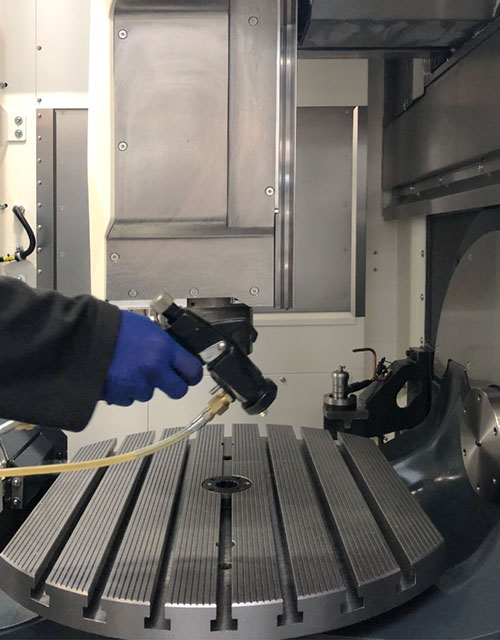New preservation standards in machine tool manufacturing and logistics
Anyone who buys something new expects faultless products in a high-quality condition. This also applies to machine tools, which must be free of visual defects and flash rust. As a leading machine tool manufacturer, DMG MORI has customers all over the world and makes no compromises in its product and service portfolio: Highest quality is the standard.
The development
When developing packaging for a machine tool, corrosion protection is an essential aspect. The selection of a successful corrosion protection concept is therefore the third essential point to consider in logistics, alongside protection against mechanical defects and dirt.
And here the question "How can I protect against rust?" alone is not enough. Because what happens if a corrosion protection medium gets into the cooling lubricant during commissioning? How can the corrosion protection be applied and removed as easily and safely as possible?
In order to find the right answers to these questions, i.e. the ones that are appropriate in each individual case, the existing processes in production and logistics must be closely examined and re-evaluated. This requires the expertise and know-how of a corrosion protection specialist like FUCHS. With projects all over the world and decades of experience, FUCHS can provide valuable support. The company thinks in terms of processes as well as coordinated lubricant systems and not just corrosion protection agents. This ultimately also benefits the users, who receive a well protected machine tool.
In order to ensure a uniform procedure for the preservation and packaging of machines and components in the DMG MORI supply or production plants, but also at external suppliers, the DMG MORI production plant in Seebach was commissioned to develop preservation and packaging standards together with FUCHS.
In principle, the following approach is being followed:
- A corrosion protection solution for short-term preservation of up to 5 days. During internal breaks and at weekends, it should reliably protect against corrosion, but without the need to clean the components before further processing.
- A solution for medium-term preservation of up to 12 months as well as EU shipping. This method is used for parts that are stored and/or shipped from a supplier.
- A solution for long-term corrosion protection of up to 24 months as well as overseas transport. This is to reliably protect finished plants during transfer to the customer.
As the last preservation before delivery to the customer, long-term corrosion protection is of particular importance. It has a decisive influence on the customer's first impression during commissioning - mistakes here can quickly become expensive.
Challenges
Criticism of the previous process at the start of the project was the lengthy conservation of the interior of the machine and the stress to which the employees were exposed. Due to the lengthy application of solvent-based products with brushes, the employees were exposed to solvent vapours for long periods of time and had to be very careful not to damage the machine or endanger themselves when entering the interior.
By running off vertical surfaces, the corrosion protection medium additionally reached places where it could theoretically cause damage. And how could the corrosion protection medium, which had hardened by then, be removed from the system before it was put into operation? This step could only be carried out with solvent-based cleaners and a lot of mechanical work - and was correspondingly time-consuming.
The solution
So the question was: how can this be done better? The answer: with a combination of spraying equipment and corrosion protection medium that is fine-tuned in detail. "What we were looking for was the best solution that met our high demands on quality, employee and environmental protection as well as efficiency!" says Roger Kluge, process optimiser at DMG MORI.
After successful corrosion protection tests, environmental and occupational health and safety tests, compatibility tests with cooling lubricants and other materials used, as well as spray tests of the FUCHS ANTICORIT TX 11 and a spray system from a well-known German manufacturer, the following advantages became apparent:
- No employee has to climb into the machine tool for preservation,
- practically no formation of spray mist, which settles in places that should not be wetted,
- no more run-off of the corrosion protection medium thanks to the run-off-inhibited ANTICORIT TX 11 and thus significantly less contamination of the interior of the machine,
- up to 80% time saving in preservation for plant dispatch,
- no odour nuisance due to the use of odourless ANTICORIT TX 11,
- significantly reduced workload for the service technician when commissioning at the destination - simply wipe off the corrosion protection oil with a dry cloth. Any residues are generally no problem thanks to good compatibility with the cooling lubricant (tested with representatives of the FUCHS ECOCOOL range) as well as
- reduced oil consumption thanks to targeted application and a comparatively thin corrosion protection film.
In the meantime, the process has been tested to such an extent and confirmed by results that the site is now investing in further application equipment.

In addition to the successes already mentioned, the partnership between DMG MORI and FUCHS has brought further advantages for the Seebach site:
- Reduction of the preservation media used at the DMG MORI site in Seebach from eight types to now two, namely ANTICORIT TX 11 for long-term preservation and ANTICORIT DFO 8101 for medium- and short-term preservation,
- a uniform DMG MORI standard "Preservation and Packaging", which is currently being transferred to other plants and suppliers.
